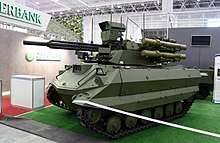Uran-9
| Uran-9 | |
|---|---|
 Uran-9 combat unmanned ground vehicle - Military-technical forum ARMY-2016 | |
| Type | Unmanned combat ground vehicle |
| Place of origin | Russia |
| Service history | |
| Used by | Russia |
| Wars | Syrian civil war |
| Production history | |
| Designed | 2015 |
| Manufacturer | JSC 766 UPTK, Impul's 2 Sevastopol' |
| Produced | 2015 |
| Specifications | |
|
| |
Main armament | 30 mm 2A72 autocannon ABM M30-M3 modification |
Secondary armament |
1 × 7.62mm PKT/PKTM 4 × 9M120 Ataka anti-tank missiles 6 (now 12) x Shmel-M thermobaric rocket launchers |
The Uran-9 is a tracked unmanned combat ground vehicle (UCGV) being developed and produced by JSC 766 UPTK, and promoted and offered by Rosoboronexport for the international market.[1][2][3] According to a release by Rosoboronexport, the system will be designed to deliver combined combat, reconnaissance and counter-terrorism units with remote reconnaissance and fire support.[4] The armament consists of a 2A72 mod ABM M30-M3 autocannon from Impul's 2 (Sevastopol') along Russian artillery and other producers, four ATGMs of the Ataka or other type, also Igla or Strela SAMs, FCS, cam IR sensors, laser rangefinder and other means for detection.
Operational history
The Uran-9 was first deployed during the Syrian Civil War, though according to a performance report of the 3rd Central Research Institute of the Ministry of Defence of the Russian Federation, the tank functioned poorly, and was unable to perform many of the missions assigned to it.[5][6] “The vehicle has been tested in Syria and demonstrated high performance in an operational environment,” an industry source claimed, noting that industry is now working to increase the Uran-9’s range, response time, and data bandwidth.[7] Uran-9 was also used in the massive Vostok-2018 drills.[8]
References
- ↑ "Rosoboronexport to start promoting Uran-9 combat robotic system" (Press release). Rostec. 30 December 2015. Retrieved 30 December 2015.
- ↑ Tamir, Eshel (31 December 2015). "Russian Military to Test Combat Robots in 2016". Defense Update. Retrieved 1 January 2016.
- ↑ Kyle, Mizokami (13 January 2016). "The Kremlin's Tiny Drone Tank Bristles With Weapons". Popular Mechanics. Retrieved 16 January 2016.
- ↑ http://www.customstoday.com.pk/russia-ready-to-export-uran-9-robotic-combat-system-in-2016/
- ↑ "Применение боевого робота "Уран-9" в Сирии выявило его недостатки" (in Russian). RIA Novosti. June 19, 2018. Retrieved June 19, 2018.
- ↑ Mizokami, Kyle (June 18, 2018). "Russia's Tank Drone Performed Poorly in Syria". Popular Mechanics.
Uran-9’s combat experience in Syria revealed serious problems with the system.
- ↑ https://www.janes.com/article/83252/russia-upgrades-uran-9-combat-ugv
- ↑ http://www.armstrade.org/includes/periodics/news/2018/0913/093548691/detail.shtml
Literature
- Paul Scharre. Army of None: Autonomous Weapons and the Future of War. — W. W. Norton & Company, 2018. — P. 114-116. — 407 p. — ISBN 9780393608991.
- Stephan De Spiegeleire, Matthijs Maas, Tim Sweijs. Artificial Intelligence and the Future of Defense: Strategic Implications For Small- and Medium-Sized Force Providers. — The Hague Centre for Strategic Studies, 2017. — P. 82. — 140 p. — ISBN 9789492102546.